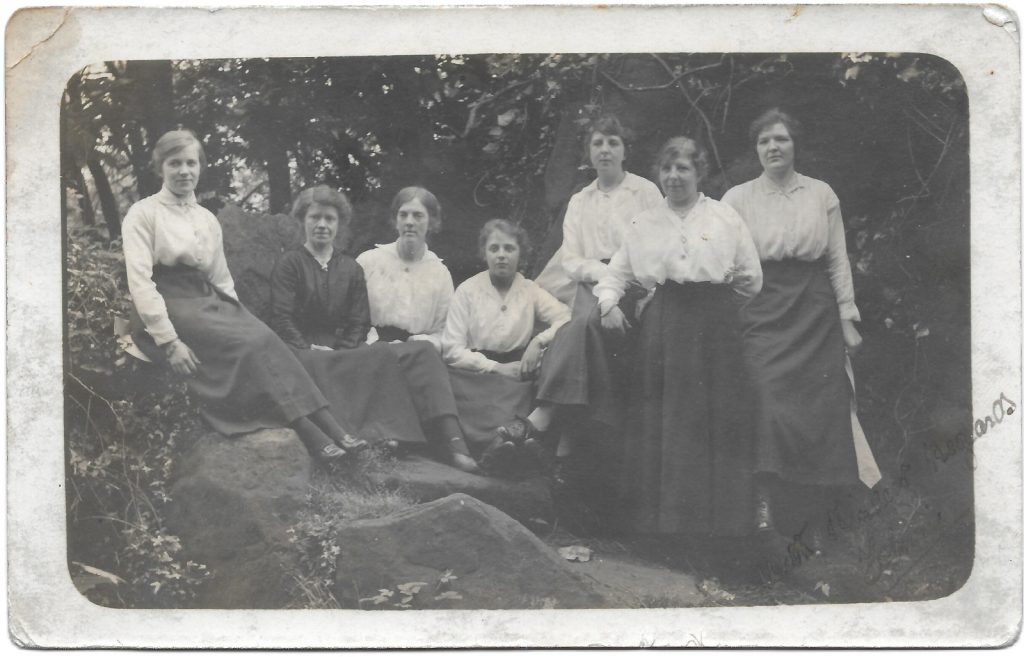This blog is one of a series published every Friday, part of a HLF funded project to ensure the legacy of those who worked and were treated at Moss Side Hospital in Maghull are not forgotten during the centenary commemorations of the Great War. You can read more about the project by clicking here.
The initial impression of the nursing and ancillary staffing at Moss Side Red Cross Military Hospital at Maghull is one of turbulence. In the very first record of minutes for the Moss Side Committee, there is notice of eight resignations, absence through illness, and the gross negligence of Male Nurse Pooley in allowing a patient to ‘escape’. There is, however, some strong evidence of commitment given by staff with sustained service, endurance through sickness and reward in the form of promotion. Ancillary staff were often from the local community and, whilst service might have been short on occasion, individuals returned when needed and overall, had a sustained connection with the hospital.
The details of 508 staff appear in the hospital Minute Books now held at Liverpool Records Office, either on the instance of their appointment or departure from service. Currently nearly 300 individuals can be tracked through their complete period of service. This information must however be used with caution, as entries often give only an initial and surname, making it difficult to be sure that two or more individuals are reflected. In addition, some of the names are clearly recorded incorrectly, reversing initials or misspelling surnames. The incomplete records are referenced by one or other of these points, or by their absence through sickness.
An analysis of the duration of service of staff with complete dates of service provides an interesting comparison between the service of male and female staff. Part one of this blog post will detail the differences between male and female nursing staff. Part two of this blog, will detail the differences between male and female ancillary staff.
Female Nursing Staff
The 78 female nurses with complete records collectively provided 17,893 days of service. There were some staff who were at Moss Side only briefly, the shortest period being 2 days, however, only 20.48% stayed for 30 or fewer days. Of those that remained after 30 days, 69.8% were in service for 90 days or more, and 25% were in service for a year or more. Three female nursing staff were in service for over 1000 days.
There are individual’s records that highlight the different backgrounds and motives of the nursing staff. Freda Louise Cornelius, a local girl of 23 and a Voluntary Aid Detachment nurse, came from a relatively affluent background and served one of the longest periods of service, 903 days. Two other VAD nurses had rather different backgrounds. Elizabeth Rose White and Ethel Florence White were already in forms of nursing service in 1911. Elizabeth had been a housemaid in Cockermouth at an ‘Inebriate Home’ which included some well-heeled patients including a surgeon, doctor, cigar importer. Ethel had been a nurse with a family in Harrogate with a likely role in caring for the three children rather than providing medical care. Dorothy McPhearson Morrison and Mary Lloyd Poggi were only in service for 11 days. They joined and left Moss Side together. Local girls and relatively young, one gets the impression that these young women were attracted to the novelty of nursing and then backed out with the reality of service at a shell shock hospital.
Male Nursing Staff:
An analysis of the duration of service of the male nursing staff shows that the 35 male nurses with complete records provided only 7437 days of service. There were some staff who were at Moss Side only briefly, with one individual, William Fay, arriving and leaving on the same day. However, 31.43% stayed for 30 or fewer days. Of those that remained after 30 days, 42.85% were in service for 90 days or more, and 22.85% were in service for a year or more. The impact of volunteering ‘to serve the colours’ became a pressing issue, as highlighted in the minute books. The male nursing staff were enlisted in the RAMC on 7 July 1915, but with demand for more troops in combat service, a list of men to be transferred was drawn up on 11 May 5 1917.

Sergeant P.J. Muscutt, an Attendant, had the longest service of any of the male nursing staff at Moss Side, serving for 1452 days. Another Muscutt, possibly a brother, was also on the staff. Arthur Botrwright was another Attendant, appointed in December 1914. Despite several instances of absence, he seems to have been well-regarded and was promoted to Charge Attendant in October 1915. He was still in service in March 1919 when it was suggested in the Minute Book that he should take over the role of the demobilised Sergeant Pettet [the Gate Porter?]. Three male nursing staff are noted as enlisting when they left service at Moss Side.
Photograph of Harry Cox, nurse, outside the Red House public house, Foxhouse Lane
Copyright: Images courtesy of Dr Rowlands
Written by: Adam Cree
Edited by: Amy Walling, Manchester Metropolitan University
Posted on 1 June 2018 under Moss Side Military Hospital







